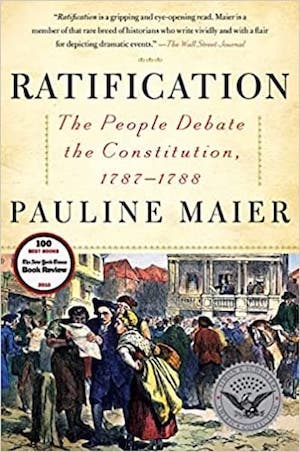This is a classic “must read” narrative account for the Constitutional Convention during which delegates from 12 of the 13 newly independent American states created the framework which gave birth to a new nation. Working from diaries and notes of delegates who attended the Convention and contemporary newspapers and pamphlets, Bowen provides an almost daily account of the debates and the issues that threatened to disrupt the proceedings and even prevent the establishment of the United States – slavery, rivalry between large and small states, and competition between north and south.
Arthur Brooks boldly confronts the growing division and anger that dominate our politics and increasingly other aspects of our lives. As both an academic and practical observer of American culture and politics and President of the American Enterprise Institute, Brooks identifies an “outrage industrial complex” that prospers by creating a “culture of contempt” – the habit of seeing people who disagree with us not as merely incorrect, but as worthless and defective. He demonstrates convincingly that abuse and outrage are not the right formula for lasting success, but that getting us to agree more with each other is not the answer. After all, disagreement is the secret to success. Moreover, competition and cooperation are not opposites; rather, they are not only compatible, but each is necessary.
Reading like an historical detective story, this tour through how our nation’s priceless documents were preserved begins with smuggling the Declaration of Independence and the Constitution out of Washington just days before the British burned the capital in 1814. More than a century later they were whisked away to Fort Knox in Kentucky along with hundreds of other documents to avoid possible attacks on the Atlantic coast of America by German naval forces at the onset of World War II. Why the seven hundred year-old British Magna Carta was among them is a part of the tale along with Dolly Madison’s quick thinking that saved her husband’s irreplaceable notes from the 1787 Constitutional Convention. Readers will also get a brief but solid history of these invaluable documents.

Drafting the Constitution was difficult, devising compromises between small and large states, industrial v. agrarian interests, and more, including the most controversial issue of all – slavery. But when the Constitutional Convention adjourned, its work resulted in a proposal only. Unless approved (ratified) by at least nine of the thirteen states, it would not go into effect. In fact, there was serious opposition to the Constitution and two states did not ratify until after the First Congress convened on March 4, 1789, and George Washington inaugurated as President on April 30, 1789.
Ratification was messy and noisy. The “Federalist Papers” argued the case for ratification. Arguments in coffee houses and taverns were vigorous. Women joined the debate in their parlors. Newspapers and pamphlets espoused a variety of views. Demands for protection of rights fought for during the Revolutionary War were central to the discussion. To really understand the history and meaning of the Constitution, it is essential to understand ratification.
A Professor of Constitutional Law and the first woman national President of the American Civil Liberties Union, Nadine Strossen provides a thoughtful and powerful essay of interest to political conservatives and liberals alike – dispelling misunderstandings plaguing our perennial debates about “hate speech v. free speech.”
Reviewing U. S. law as well as citing hate-speech laws in other countries, Strossen argues that the best way to resist hate and promote equality is not censorship, but rather, vigorous “counter-speech” and activism. She concludes that “the progress we already have made [with respect to liberty, equality, democracy, individual well-being and societal harmony] – through more speech, not less – should encourage us to stay the course. All of us must exercise what it the most essential right of all, for promoting these vital causes: the right not to remain silent.
View a conversation with Nadine Strossen here.
Born a slave who escaped at the age of twenty, Douglass mastered the skill of reading and writing to become one of the greatest writers of his era and a celebrated orator for the cause of abolition. A believer with considerable knowledge of the Bible, he warned America about the evils of slavery, advised President Abraham Lincoln and is considered by many to be the African American founder of the nation’s second republic – a new nation arising from the Civil War.
One of the New York Times’ 10 Best Books of the Year, this monumental biography is a must for anyone who wants to understand the complete history of the United States.
Following the drafting of the Constitution in 1787, its drafters faced an uphill battle to achieve its ratification. Detractors were quick to point out its flaws as well as seizing on the peoples’ opposition to a strong national government which, they feared, would threaten the independence and authority of the individual states. Alexander Hamilton, James Madison and John Jay sought to explain the new Constitution section by section to counter arguments of its opponents and assuage the concerns of the people.
Initially printed as a series of newspaper articles, the individual papers were soon circulated in book form and became the most authoritative explanation of the Constitution and why is should be ratified. Witnesses is a vivid story of three men and their unparalleled contribution to the founding of the United States.